Metallurgical Aspects of Ni-Coating and High Temperature Treatments for FBG Spectrum Regeneration
Abstract
1. Introduction
2. Materials and Methods
2.1. Fiber Preparation for the Ni Electrodeposition
2.2. Ni Coating via Electrodeposition
2.3. Coated Fiber Bragg Grating Samples
2.4. Thermal and Cycling Treatments
3. Results and Discussion
3.1. Effect of Temperature on Grain Growth
3.2. Effect of Current Density on Grain Growth
3.3. Effect of Thermal Treatment on FBG Spectrum
4. Conclusions
Author Contributions
Funding
Institutional Review Board Statement
Informed Consent Statement
Data Availability Statement
Conflicts of Interest
References
- Mihailov, S.J. Fiber Bragg Grating Sensors for Harsh Environments. Sensors 2012, 12, 1898–1918. [Google Scholar] [CrossRef] [PubMed]
- Wang, X.; Sun, X.; Hu, Y.; Zeng, L.; Liu, Q.; Duan, J. Highly-sensitive fiber Bragg grating temperature sensors with metallic coatings. Optik 2022, 262, 169337. [Google Scholar] [CrossRef]
- Hill, K.; Meltz, G. Fiber Bragg grating technology fundamentals and overview. J. Light. Technol. 1997, 15, 1263–1276. [Google Scholar] [CrossRef]
- Ma, Y.; Sun, X.; Si, X.; Peng, L.; Wang, H.; Zhu, Y.-F.; Wu, L.; Yi, L.; Li, L.; Zhao, X.; et al. Thermal stability of fiber Bragg gratings fabricated by 193 nm excimer laser. Opt. Commun. 2022, 516, 128286. [Google Scholar] [CrossRef]
- Pal, S.; Mandal, J.; Sun, T.; Grattan, K.T.V. Analysis of thermal decay and prediction of operational lifetime for a type I boron-germanium codoped fiber Bragg grating. Appl. Opt. 2003, 42, 2188–2197. [Google Scholar] [CrossRef]
- Li, Y.; Feng, Y.; Peng, X.; Zhang, H. Simultaneous measurement of the temperature and force using a steel cantilever soldered with a partially nickel coated in-fibre Bragg grating. Opt. Commun. 2012, 285, 4275–4279. [Google Scholar] [CrossRef]
- Elsmann, T.; Lorenz, A.; Yazd, N.S.; Habisreuther, T.; Dellith, J.; Schwuchow, A.; Bierlich, J.; Schuster, K.; Rothhardt, M.; Kido, L.; et al. High temperature sensing with fiber Bragg gratings in sapphire-derived all-glass optical fibers. Opt. Express 2014, 22, 26825–26833. [Google Scholar] [CrossRef]
- Deng, Y.; Jiang, J. Optical Fiber Sensors in Extreme Temperature and Radiation Environments: A Review. IEEE Sens. J. 2022, 22, 13811–13834. [Google Scholar] [CrossRef]
- Mihailov, S.; Hnatovsky, C.; Abdukerim, N.; Walker, R.; Lu, P.; Xu, Y.; Bao, X.; Ding, H.; De Silva, M.; Coulas, D.; et al. Ultrafast Laser Processing of Optical Fibers for Sensing Applications. Sensors 2021, 21, 1447. [Google Scholar] [CrossRef]
- Feng, Y.; Toyserkani, E.; Zhang, H.; Zhang, Z.-D. Temperature Sensing of Stepped-Metal Coated Optical Fiber Bragg Grating with the Restructured Dual-Peak Resonance. Appl. Sci. 2019, 9, 286. [Google Scholar] [CrossRef]
- Soman, A.C.; Chalackal, A.T.; Kanakambaran, S. Design of Cryogenic Temperature Sensors using Copper-Coated Fiber Bragg Gratings. In Proceedings of the 2022 IEEE Region 10 Symposium (TENSYMP), Mumbai, India, 1–3 July 2022; pp. 1–5. [Google Scholar] [CrossRef]
- Bian, Q.; Podhrazsky, A.; Bauer, C.; Stadler, A.; Buchfellner, F.; Kuttler, R.; Jakobi, M.; Volk, W.; Koch, A.W.; Roths, J. Temperature and external strain sensing with metal-embedded optical fiber sensors for structural health monitoring. Opt. Express 2022, 30, 33449. [Google Scholar] [CrossRef] [PubMed]
- Guo, Y.; Xiong, L.; Liu, H. Research on the Durability of Metal-Packaged Fiber Bragg Grating Sensors. IEEE Photon- Technol. Lett. 2019, 31, 525–528. [Google Scholar] [CrossRef]
- Rosolem, J.B.; Penze, R.S.; Floridia, C.; Peres, R.; Vasconcelos, D.; Junior, M.A.R. Techniques and Materials for Optical Fiber Sensors Sealing in Dynamic Environments with High Pressure and High Temperature. Sensors 2021, 21, 6531. [Google Scholar] [CrossRef] [PubMed]
- Lupi, C.; Felli, F.; Brotzu, A.; Caponero, M.A.; Paolozzi, A. Improving FBG Sensor Sensitivity at Cryogenic Temperature by Metal Coating. IEEE Sens. J. 2008, 8, 1299–1304. [Google Scholar] [CrossRef]
- Lai, L.-H.; Shiue, S.-T.; Lin, H.-Y. Effects of radio-frequency powers on the properties of carbon coatings on optical fibers prepared by thermal chemical vapor deposition enhanced with inductively coupled plasma. Vacuum 2013, 87, 141–144. [Google Scholar] [CrossRef]
- Shiue, S.-T.; Chen, P.-Y.; Lee, R.-H.; Chen, T.-S.; Lin, H.-Y. Effects of deposition parameters on characteristics of carbon coatings on optical fibers prepared by thermal chemical vapor deposition. Surf. Coat. Technol. 2010, 205, 780–786. [Google Scholar] [CrossRef]
- Alberto, N.J.; Kalinowski, H.J.; Neto, V.F.; Nogueira, R.N. Regeneration of FBGs during the HFCVD diamond-fiber coating process. Second Int. Conf. Appl. Opt. Photonics 2014, 9286, 549–552. [Google Scholar] [CrossRef]
- Alberto, N.; Kalinowski, H.J.; Neto, V.; Nogueira, R. Diamond-coated fiber Bragg grating through the hot filament chemical vapor process for chemical durability improvement. Appl. Opt. 2017, 56, 1603–1609. [Google Scholar] [CrossRef]
- Rao, C.; Zhang, H.; Feng, Y.; Xiao, L.; Ye, Z. Effect of metalizing nickel on the spectrum of fiber Bragg grating. Opt. Eng. 2013, 52, 054404. [Google Scholar] [CrossRef]
- Shen, R.-S.; Teng, R.; Li, X.-P.; Zhang, J.; Xia, D.-C.; Fan, Z.-Q.; Yu, Y.-S.; Zhang, Y.-S.; DU, G.-T. Electroless Nickel Plating and Electroplating on FBG Temperature Sensor. Chem. Res. Chin. Univ. 2008, 24, 635–639. [Google Scholar] [CrossRef]
- Jiang, B.; Xiao, L.; Hu, S.; Peng, J.; Zhang, H.; Wang, M. Optimization and kinetics of electroless Ni–P–B plating of quartz optical fiber. Opt. Mater. 2009, 31, 1532–1539. [Google Scholar] [CrossRef]
- Vendittozzi, C.; Felli, F.; Lupi, C. Modeling FBG sensors sensitivity from cryogenic temperatures to room temperature as a function of metal coating thickness. Opt. Fiber Technol. 2018, 42, 84–91. [Google Scholar] [CrossRef]
- Li, Y.; Yang, K.; Li, X. Temperature sensing characteristics of metal coated FBG during dynamic cooling process. Opt. Fiber Technol. 2018, 45, 368–375. [Google Scholar] [CrossRef]
- Lupi, C.; Pasquali, M.; Dell’Era, A. Nickel and cobalt recycling from lithium-ion batteries by electrochemical processes. Waste Manag. 2005, 25, 215–220. [Google Scholar] [CrossRef]
- Lupi, C.; Dell’Era, A.; Pasquali, M. Effectiveness of sodium citrate on electrodeposition process of Ni Co W alloys for hydrogen evolution reaction. Int. J. Hydrogen Energy 2017, 42, 28766–28776. [Google Scholar] [CrossRef]
- Ciro, E.; Dell’Era, A.; Razzi, M.; Lupi, C. Optimization of indium electrowinning from sulfate solutions on Ni cathode. J. Clean. Prod. 2022, 347, 131309. [Google Scholar] [CrossRef]
- Ciro, E.; Dell’Era, A.; Pasquali, M.; Lupi, C. Indium electrowinning study from sulfate aqueous solution using different metal cathodes. J. Environ. Chem. Eng. 2020, 8, 103688. [Google Scholar] [CrossRef]
- Lupi, C.; Vendittozzi, C.; Ciro, E.; Felli, F. FBG Spectrum Regeneration by Ni-Coating and High-Temperature Treatment. Sensors 2022, 22, 7255. [Google Scholar] [CrossRef]
- Liang, Z.; Ahn, H.S.; Bard, A.J. A Study of the Mechanism of the Hydrogen Evolution Reaction on Nickel by Surface Interrogation Scanning Electrochemical Microscopy. J. Am. Chem. Soc. 2017, 139, 4854–4858. [Google Scholar] [CrossRef]
- Tamm, J.; Tamm, L.; Arol’D, J. Cathodic Hydrogen Evolution on Nickel in Acidic Environment. Russ. J. Electrochem. 2004, 40, 1152–1155. [Google Scholar] [CrossRef]
- Lupi, C.; Pasquali, M. Electrolytic nickel recovery from lithium-ion batteries. Miner. Eng. 2003, 16, 537–542. [Google Scholar] [CrossRef]
- Volmer, M.; Weber, A.Z. Die Kinetik der Phasenbildung. Bücherschau 1940, 46, 327. [Google Scholar] [CrossRef]
- Rashidi, A.; Amadeh, A. The effect of saccharin addition and bath temperature on the grain size of nanocrystalline nickel coatings. Surf. Coat. Technol. 2009, 204, 353–358. [Google Scholar] [CrossRef]
- Natter, H.; Hempelmann, R. Nanocrystalline Metals Prepared by Electrodeposition. Z. Für Phys. Chem. 2008, 222, 319–354. [Google Scholar] [CrossRef]
- Rashidi, A.; Amadeh, A. The effect of current density on the grain size of electrodeposited nanocrystalline nickel coatings. Surf. Coat. Technol. 2008, 202, 3772–3776. [Google Scholar] [CrossRef]
- Winand, R. Electrocrystallization—Theory and applications. Hydrometallurgy 1992, 29, 567–598. [Google Scholar] [CrossRef]
- Winand, R. Electrodeposition of metals and alloys—New results and perspectives. Electrochim. Acta 1994, 39, 1091–1105. [Google Scholar] [CrossRef]
- Choo, R.; Toguri, J.; El-Sherik, A.; Erb, U. Mass transfer and electrocrystallization analyses of nanocrystalline nickel production by pulse plating. J. Appl. Electrochem. 1995, 25, 384–403. [Google Scholar] [CrossRef]
- El-Sherik, A.; Erb, U.; Page, J. Microstructural evolution in pulse plated nickel electrodeposits. Surf. Coat. Technol. 1997, 88, 70–73. [Google Scholar] [CrossRef]
- Ebrahimi, F.; Ahmed, Z. The effect of current density on properties of electrodeposited nanocrystalline nickel. J. Appl. Electrochem. 2003, 33, 733–739. [Google Scholar] [CrossRef]
- Qu, N.S.; Zhu, D.; Chan, K.C.; Lei, W.N. Pulse electrodeposition of nanocrystalline nickel using ultra narrow pulse width and high peak current density. Surf. Coat. Technol. 2003, 168, 123–128. [Google Scholar] [CrossRef]
- Yang-Tao, X.; Yu-Jie, D.; Wei, Z.; Tian-Dong, X. Microstructure and texture evolution of electrodeposited coatings of nickel in the industrial electrolyte. Surf. Coat. Technol. 2017, 330, 170–177. [Google Scholar] [CrossRef]
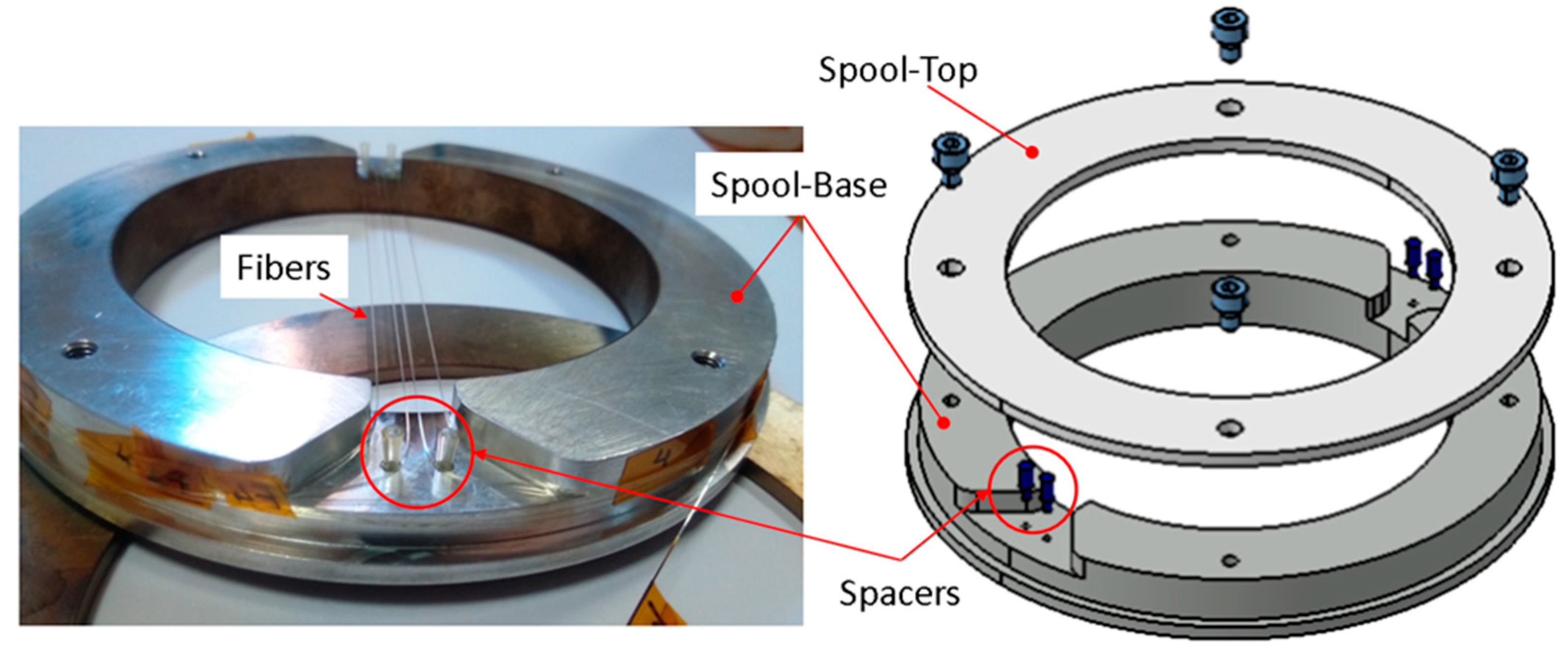


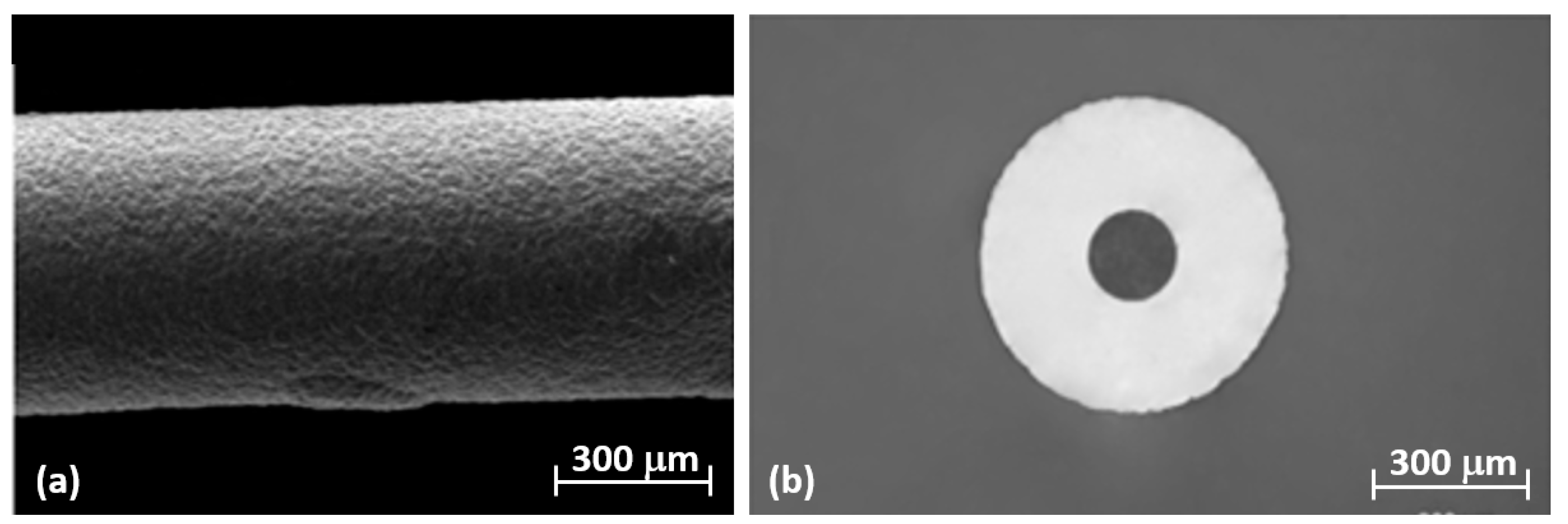
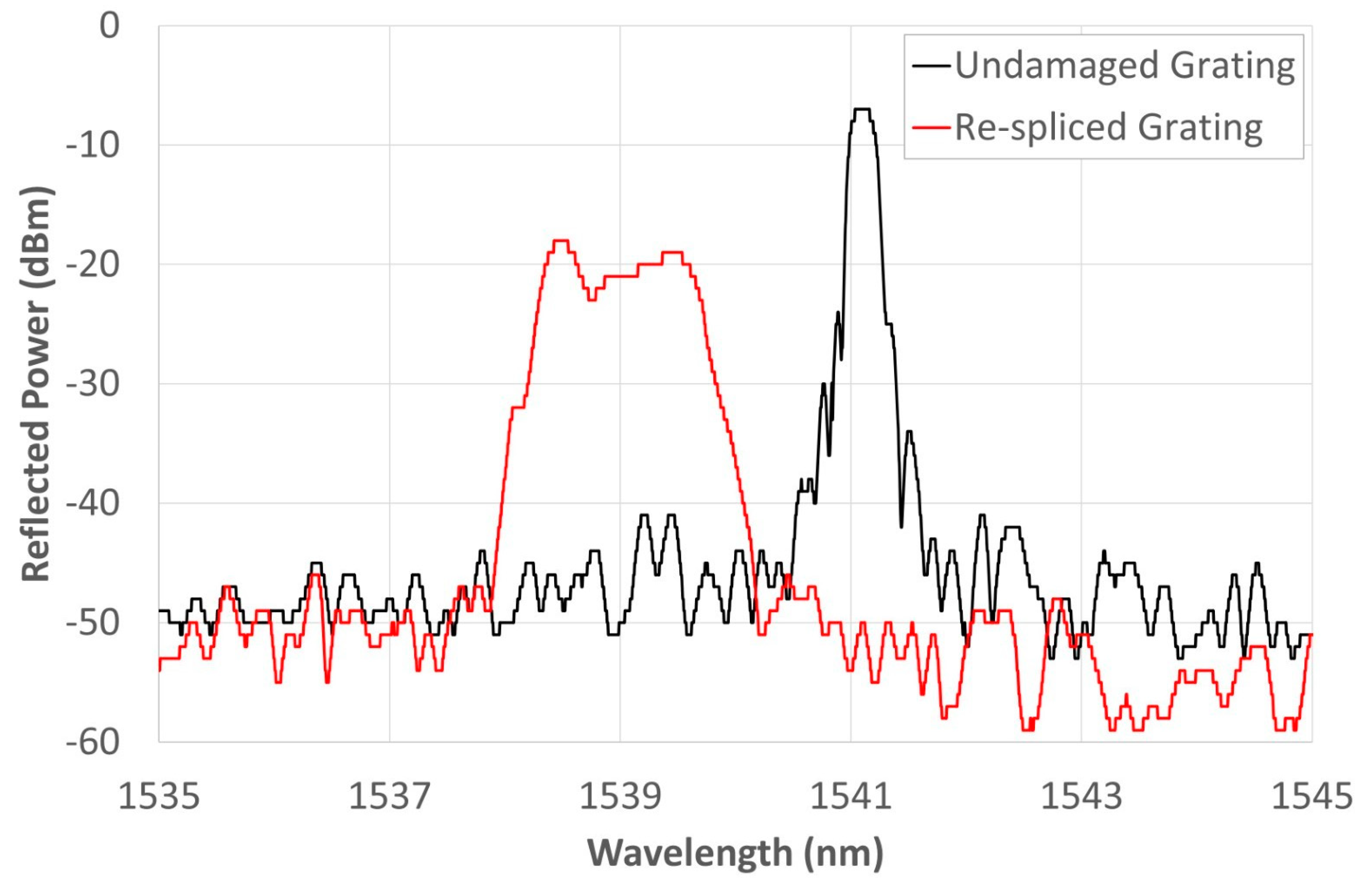
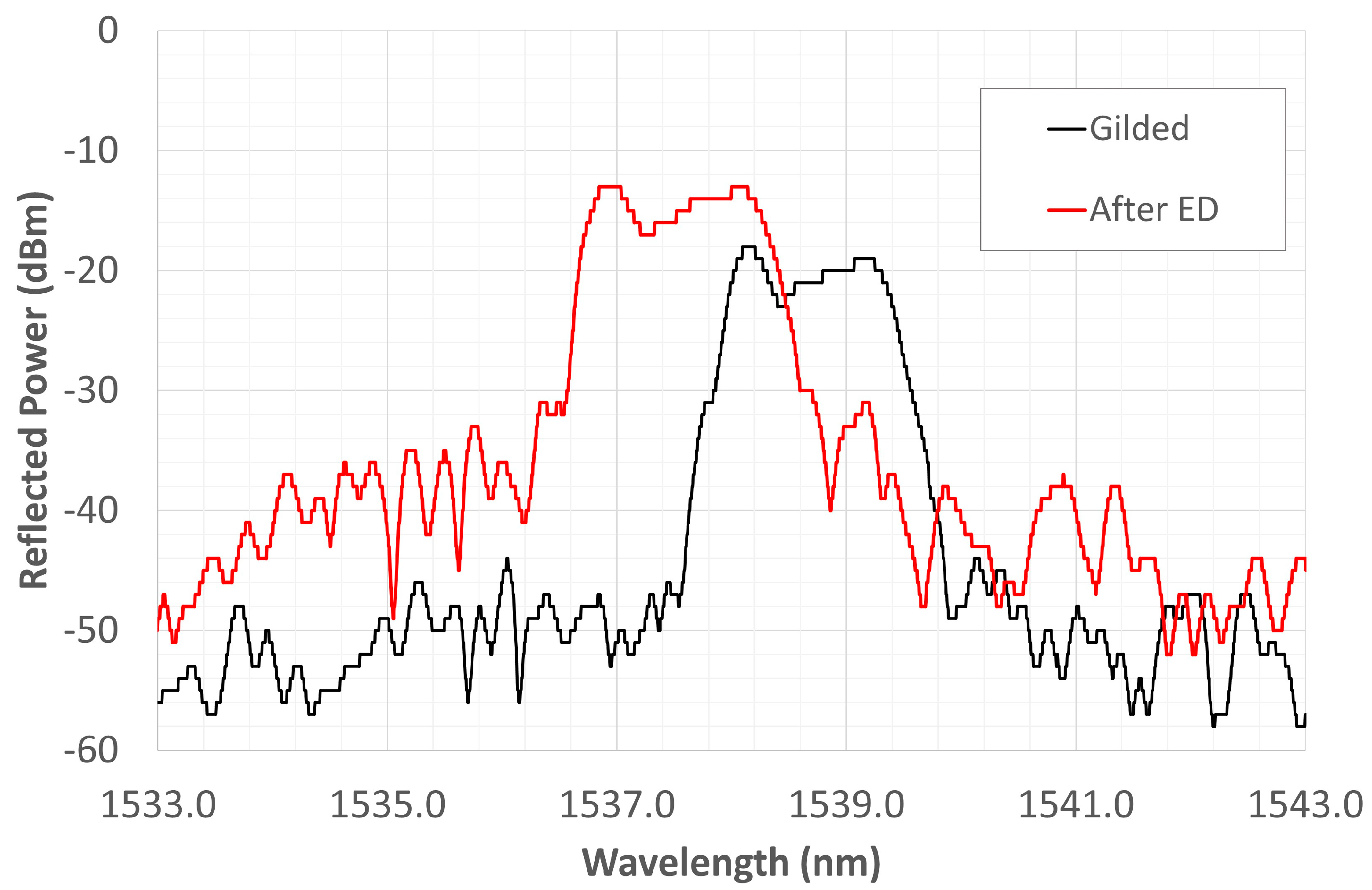

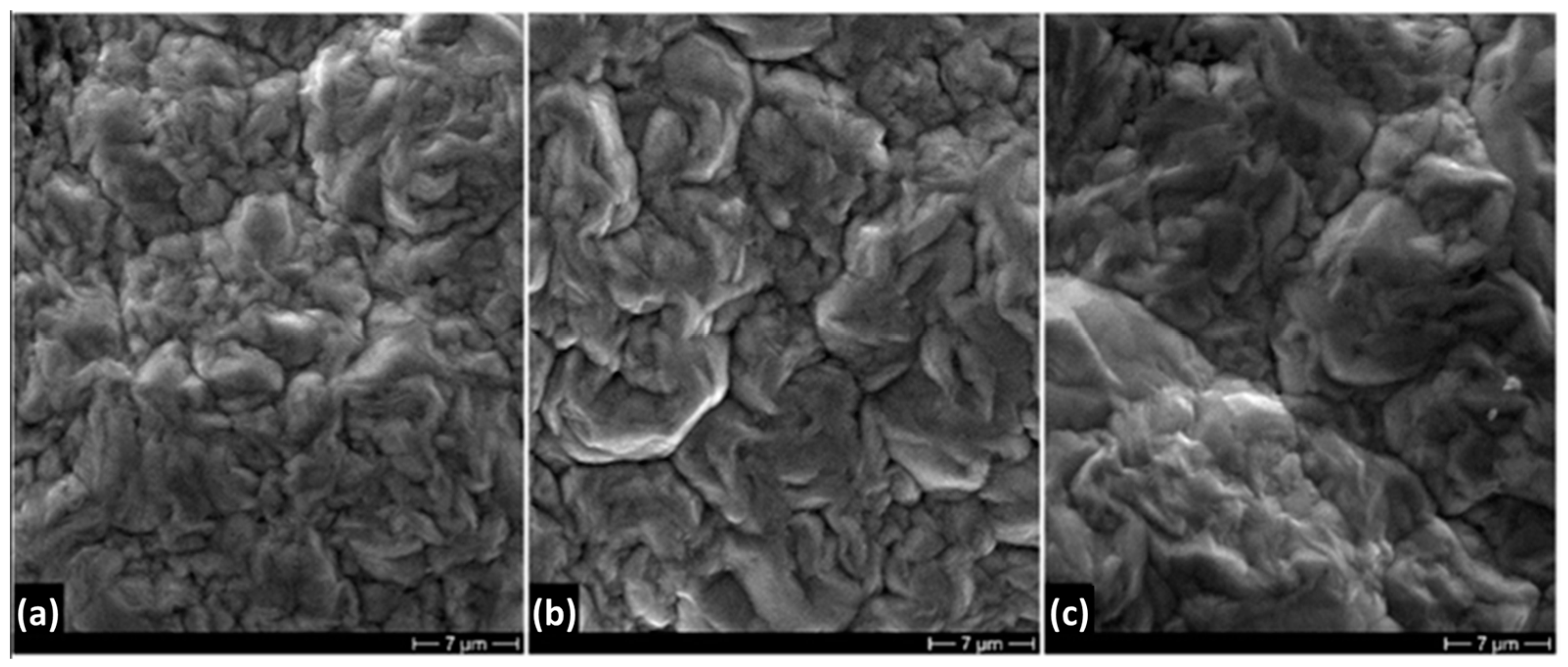
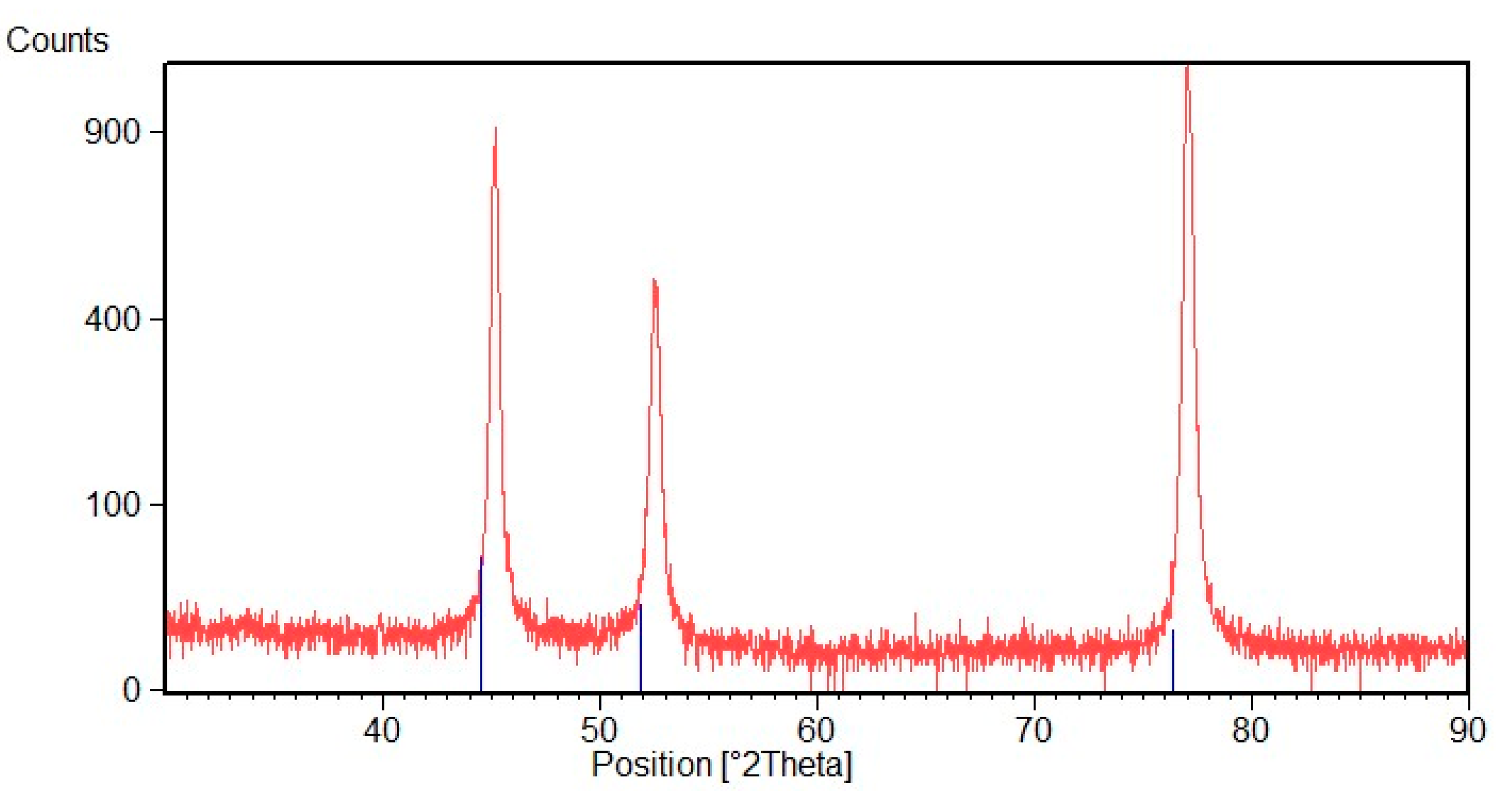
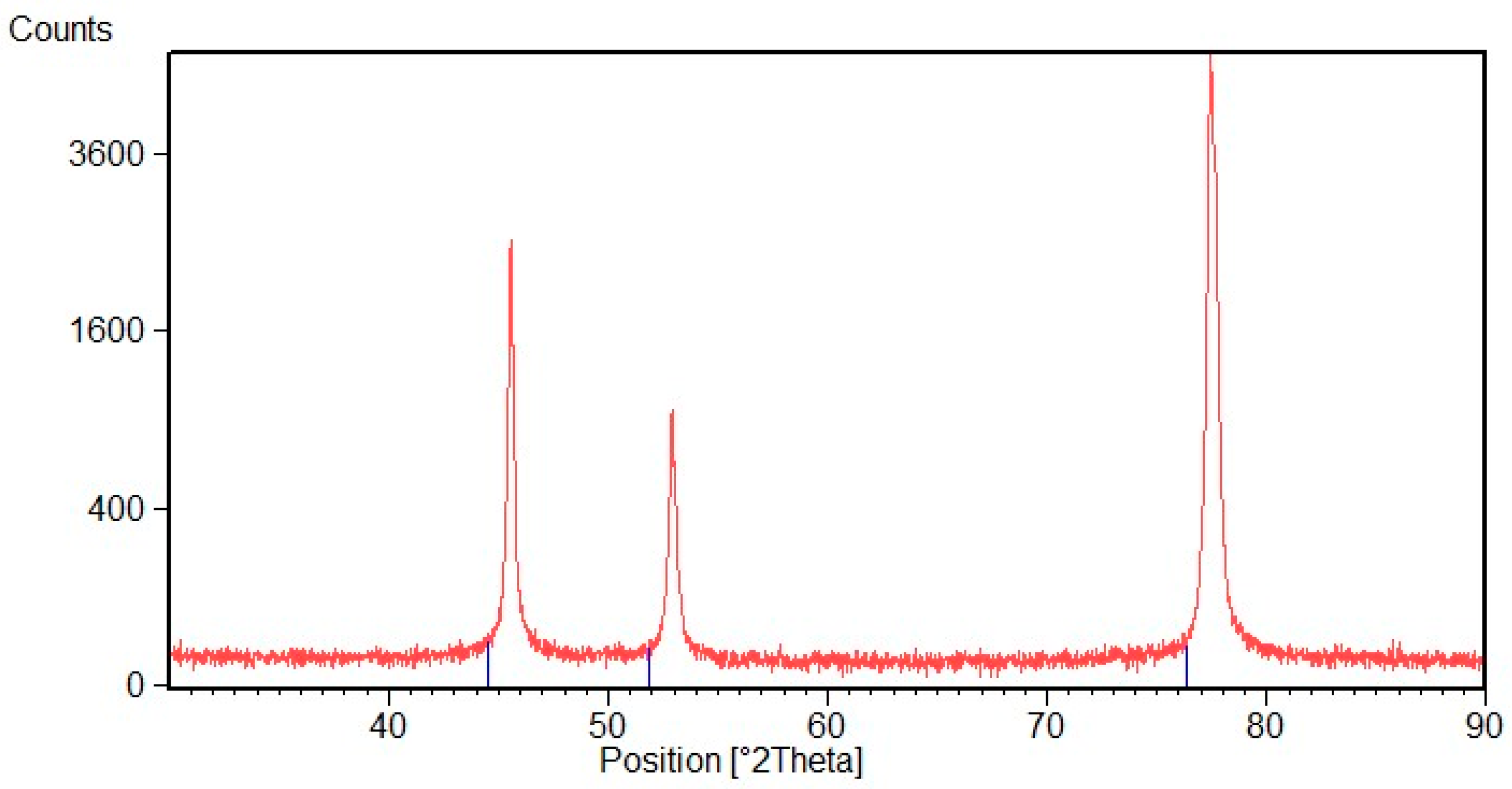
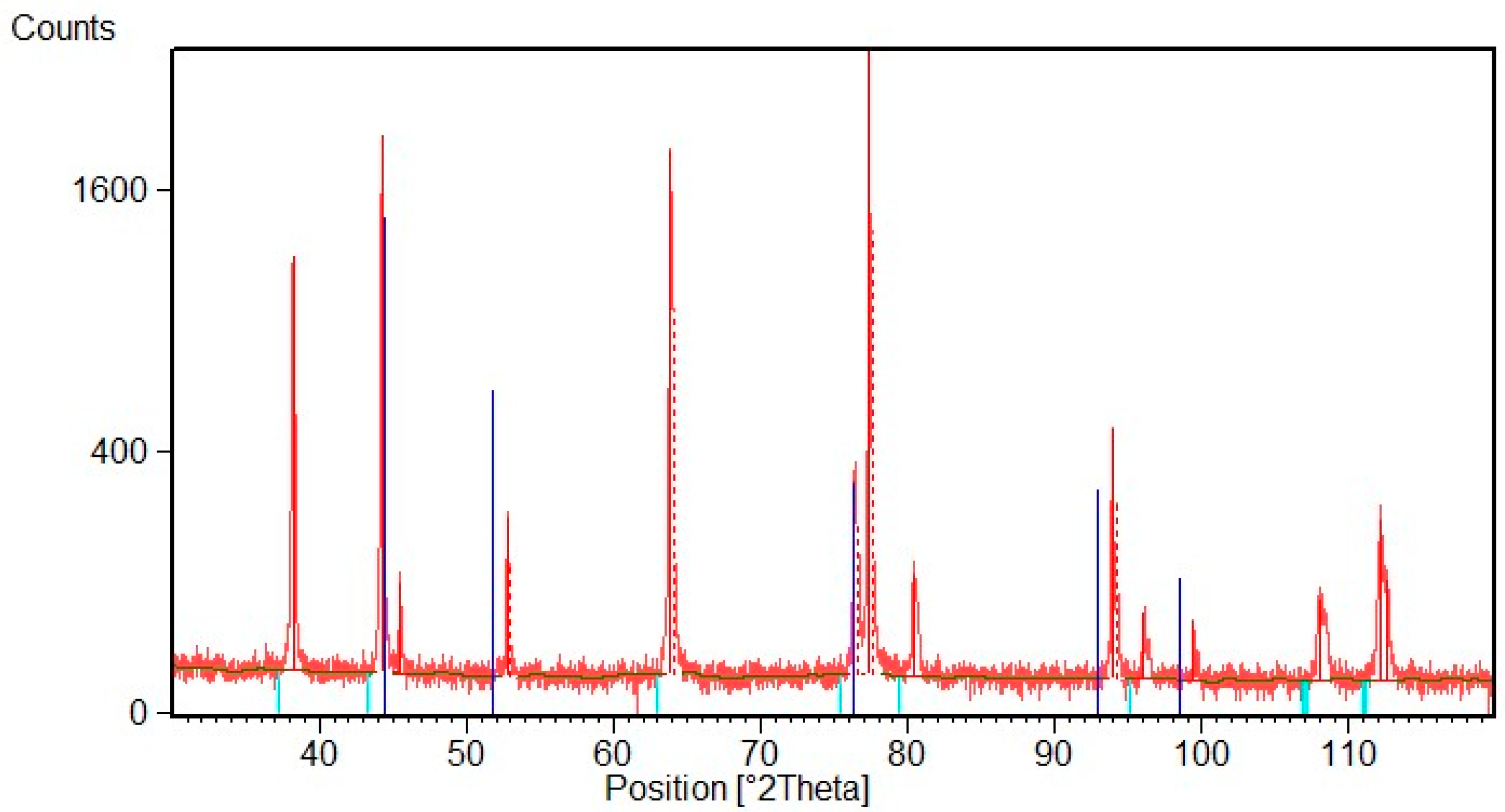
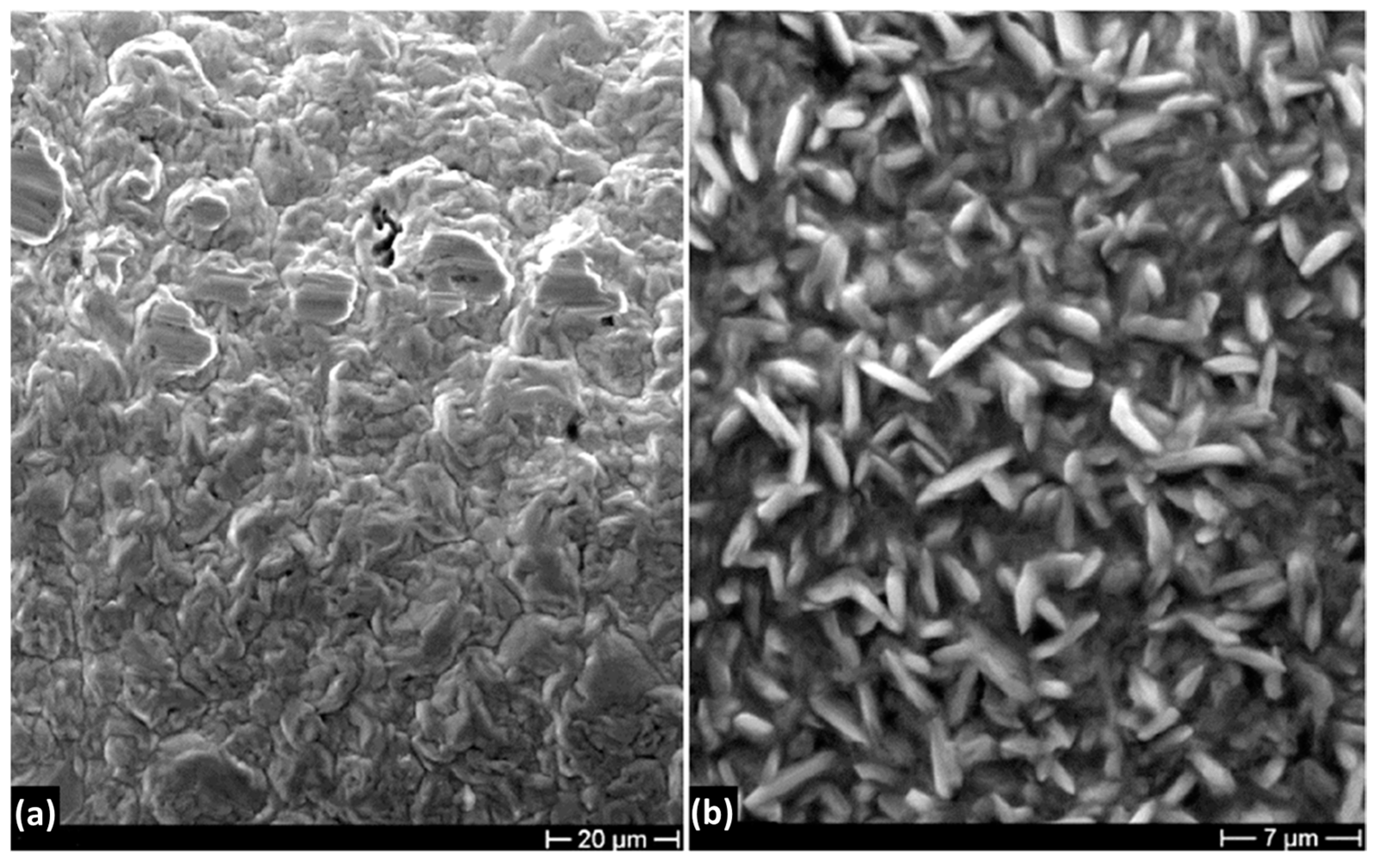


| Assessment | Heating Cycle (°C) | Cooling Cycle (°C) | Aim | Characterization |
|---|---|---|---|---|
| Thermal treatment on dummy samples | RT-170 | 170-RT | Elimination of hydrogen and stress | SEM and XRD |
| RT-800 | 800-RT | |||
| I Thermal cycle | RT-750 | 750-RT | Evaluation of high-temperature effect on coating | Grating analysis |
| II Thermal cycle | RT-800 | 800-RT |
Disclaimer/Publisher’s Note: The statements, opinions and data contained in all publications are solely those of the individual author(s) and contributor(s) and not of MDPI and/or the editor(s). MDPI and/or the editor(s) disclaim responsibility for any injury to people or property resulting from any ideas, methods, instructions or products referred to in the content. |
© 2023 by the authors. Licensee MDPI, Basel, Switzerland. This article is an open access article distributed under the terms and conditions of the Creative Commons Attribution (CC BY) license (https://creativecommons.org/licenses/by/4.0/).
Share and Cite
Lupi, C.; Vendittozzi, C.; Ciro, E.; Felli, F.; Pilone, D. Metallurgical Aspects of Ni-Coating and High Temperature Treatments for FBG Spectrum Regeneration. Materials 2023, 16, 2943. https://doi.org/10.3390/ma16082943
Lupi C, Vendittozzi C, Ciro E, Felli F, Pilone D. Metallurgical Aspects of Ni-Coating and High Temperature Treatments for FBG Spectrum Regeneration. Materials. 2023; 16(8):2943. https://doi.org/10.3390/ma16082943
Chicago/Turabian StyleLupi, Carla, Cristian Vendittozzi, Erwin Ciro, Ferdinando Felli, and Daniela Pilone. 2023. "Metallurgical Aspects of Ni-Coating and High Temperature Treatments for FBG Spectrum Regeneration" Materials 16, no. 8: 2943. https://doi.org/10.3390/ma16082943
APA StyleLupi, C., Vendittozzi, C., Ciro, E., Felli, F., & Pilone, D. (2023). Metallurgical Aspects of Ni-Coating and High Temperature Treatments for FBG Spectrum Regeneration. Materials, 16(8), 2943. https://doi.org/10.3390/ma16082943








